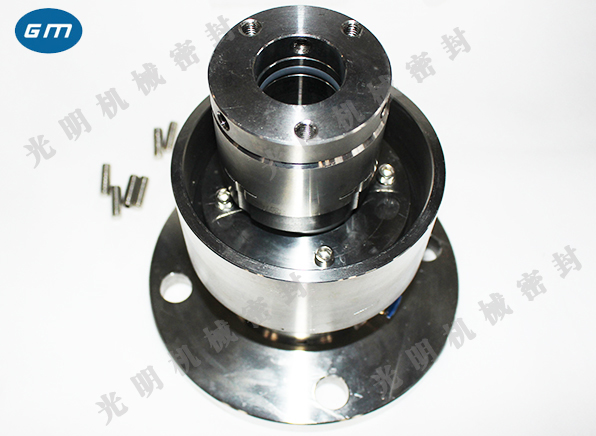Mechanical seal for kettle Attention
When installing
1. Pay great attention to avoid installation deviation during installation
(1) The gland shall be tightened after the alignment of the coupling. The bolts shall be evenly supported to prevent the end face of the gland from deflecting. Check each point with a feeler gauge, and the error shall not be greater than 0.05 mm.
(2) Check the fit clearance (i.e. concentricity) between the gland and the outer diameter of the shaft or shaft sleeve, and make sure that it is even all around. Use a feeler gauge to check that the tolerance of each point is not more than 0.01mm.
2. The spring compression shall be carried out according to the regulations, and it is not allowed to be too large or too small. The required error is 2.00mm. If it is too large, the end face pressure will be increased to accelerate the end face wear. If it is too small, the specific pressure will be insufficient and the sealing effect will not be achieved.
3. After the moving ring is installed, it should spring back automatically after pressing it against the spring.
Position requirements during installation
In order to ensure the stable operation, long life and low leakage performance of mechanical seal, it is very important to correctly install it on the machine. Precautions during installation:

1. Confirmation of components
When the mechanical seal is installed on the machine, it should be well compared with the general assembly drawing before installation to confirm whether the parts are ready. At this time, it should pay attention to whether there are any scars, defects and other abnormalities on the sealing surface of the seal friction pair and the seal ring, and also pay attention to whether there are scars on the shaft or shaft sleeve surface, flange and other components that contact with the packing, seal ring (O ring), etc, If any abnormality is found, it must be replaced or repaired before use.
During the actual installation, do not bring more parts than necessary to the site, so that if there are surplus parts after the installation, there is a missing part during the installation; If the parts are insufficient, it means that unnecessary parts are also assembled, which also plays the role of self inspection during installation.
(It is wrong to think that a good assembler does not need drawings and other marks. Then he is just a skilled worker, not a good repairman.)
2. Installation position
The installation essentials vary with the type of mechanical seal and the type of machine. I will not repeat it here.
Technical requirements during installation
Mechanical seal is a high precision mechanical part, and its correct installation and operation will greatly affect its service life. We generally follow the standards stipulated by the Ministry of Petrochemical Industry.
The technical requirements for the matching part of the pump with mechanical seal are as follows:
1. Shaft bending: no more than 0.05 mm at most;
2. Rotor runout: not greater than 0.06 mm near the shaft sleeve at the dynamic ring seal ring;
3. The axial displacement of the shaft is not allowed to exceed ± 0.5mm. If there is a shaft sleeve, it is not allowed to loose the shaft sleeve;
4. Alignment error of coupling: not more than 0.08~0.10mm for gear coupling (P2008C), not more than 0.05~0.06mm for elastic coupling; (customary end jump<0.05, radial jump<0.10)
5. The concentricity tolerance of the gland (stationary ring seat) and the seal mating lip to the shaft centerline is 0.05 mm, and the perpendicularity tolerance of the plane contacting the gasket to the centerline is 0.03~0.05 mm. If the requirements are not met, the seal cavity should be processed;
6. The end of the shaft sleeve for installing the dynamic ring seal ring and the end of the gland (or housing) for installing the static ring seal ring shall be chamfered and smoothed.
1. The mechanical seal shall be carefully installed and disassembled. It is forbidden to use a hammer or flat shovel to avoid damaging the sealing elements. If scaling cannot be removed, it shall be cleaned before removal.
2. If mechanical seals are used at both ends of the pump, take care of each other during assembly and disassembly to prevent neglect of one thing and loss of another.
3. For the operated mechanical seal, if the gland is loose and the seal moves, the moving and stationary ring parts must be replaced and should not be tightened again for further use. Because the original running track of the friction pair will change after loosening, the sealing of the contact surface is easily damaged.











